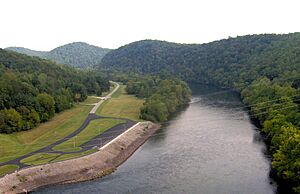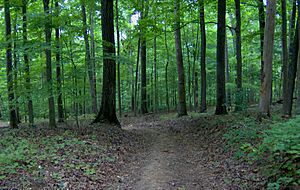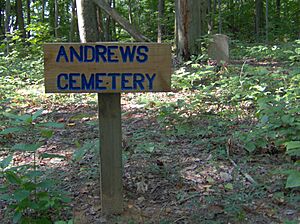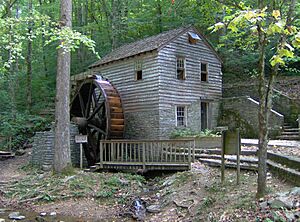Norris Dam State Park facts for kids
Quick facts for kids Norris Dam State Park |
|
|---|---|
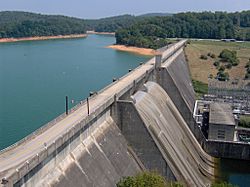
Norris Dam
|
|
| Type | state park |
| Location | Anderson County and Campbell County, Tennessee |
| Area | 4,038 acres (16.34 km2) |
| Created | 1953 |
| Operated by | Tennessee Department of Environment and Conservation |
| Website | Norris Dam State Park |
Norris Dam State Park is a cool place to visit in Anderson County and Campbell County, Tennessee. It's located in the southeastern part of the United States. This park sits right on the shores of Norris Lake. This big lake was made when Norris Dam was finished in 1936. The park covers about 4,038 acres (1,634 km2). It's looked after by the Tennessee Department of Environment and Conservation. The park also has the Lenoir Museum Complex. This museum teaches visitors about the area's history, from ancient times to the early 1900s.
Norris Dam was the very first project of the Tennessee Valley Authority (TVA). The TVA was created by the U.S. government in 1933. This happened during the Great Depression, a time when many people were struggling. The TVA's main goals were to stop floods, bring electricity to homes, and help the economy grow in the Tennessee Valley. Building Norris Dam and its lake helped the TVA learn how to build more than two dozen other dams later on.
Besides Norris Dam State Park, there are other protected areas around Norris Lake. These include Big Ridge State Park and Chuck Swan State Forest. Norris Dam State Park is named after George William Norris. He was a senator from Nebraska who worked hard to create the Tennessee Valley Authority.
Contents
Where is Norris Dam State Park?
The Clinch River starts in Virginia and flows southwest for about 300 miles (480 km). It eventually joins the Tennessee River near Kingston. Norris Dam is located about 79 miles (127 km) upstream from where the Clinch River meets the Tennessee River.
Norris Lake is a huge lake that stretches for about 73 miles (117 km) along the Clinch River. It also covers parts of the Powell River and Cove Creek. The park itself has two main sections. One section is west of the dam, and the other is east of it. Both parts are on the south side of Norris Lake. The Lenoir Museum Complex is also part of the park. It's located just below the dam on the east side of the river.
You can get to the park using U.S. Route 441, which goes right over the dam. This road connects the Norris area to Rocky Top and Knoxville. The city of Norris was built at the same time as the dam in the 1930s. It's just a few miles south of the dam.
Nature at the Park
Norris Dam State Park is in the Ridge-and-Valley Appalachians. This area has long, narrow hills and wide river valleys. The park's hills are made of sedimentary rocks. These rocks include limestone, dolomite, shale, and sandstone. They formed a very long time ago, about 400-500 million years ago.
Most of Norris Dam State Park is covered by an Appalachian oak-pine forest. Many of these trees have grown back after being cut down in the past. You'll see many types of oak trees here, like blackjack oak, chestnut oak, and red oak. Common evergreen trees include the shortleaf pine and the loblolly pine. Other trees you might spot are red maple, yellow poplar, and different kinds of hickory trees. Smaller trees like dogwood and sourwood grow under the taller trees.
Park History
People have lived in the Norris area for a very long time. Scientists believe people were here as far back as 8,000 to 1,000 BC. Before Norris Lake was created, archaeologists studied the area. They found 23 ancient sites, including burial mounds and old townhouses. They learned a lot about the Native American cultures that lived here.
The Cherokee tribe controlled this region when the first English explorers arrived in the mid-1700s. Explorers and traders came through the Clinch River Valley in the 1760s. The first European settlers arrived in the Anderson and Campbell County areas in the 1790s.
For many years, the Norris area was not very crowded. Most people lived on small farms, growing food for themselves. When the TVA built the dam, they had to move about 2,841 families. Many of these early settlers are buried in cemeteries within the state park, like Andrews Cemetery.
In the 1920s, people started asking the government to build a dam on the Clinch River. They wanted to stop floods in cities like Dayton and Chattanooga. When the Tennessee Valley Authority was formed in 1933, they took over the dam project. They named it the "Norris Project" after Senator George Norris. He was a big supporter of the TVA.
Norris Dam and its lake helped control the river's depth. This stopped floods and made it easier for boats to travel. The dam also made electricity, which was very important for the area to grow. The city of Norris was built as a planned community for the dam workers. Construction on Norris Dam started on October 1, 1933, and the dam's gates closed on March 4, 1936.
Historic Cabins
|
Norris Dam State Park Rustic Cabins Historic District
|
|
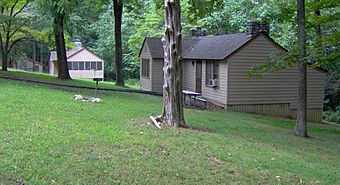 |
|
| Lua error in Module:Location_map at line 420: attempt to index field 'wikibase' (a nil value). | |
| Location | Norris Dam State Park, Norris, Tennessee |
|---|---|
| Area | 37 acres (15 ha) |
| Built | 1934–1953 |
| NRHP reference No. | 14000446 |
| Added to NRHP | July 25, 2014 |
The older part of Norris Dam State Park was built in the 1930s. The Civilian Conservation Corps (CCC) helped build it. The CCC was a program during the Great Depression that gave jobs to young men. They built a lodge, many rustic cabins, and an outdoor theater. In 1953, this land was sold to the State of Tennessee. The state later added a more modern section to the park in the 1970s. The area built by the CCC was added to the National Register of Historic Places in 2014.
The Park Today
The older, east section of Norris Dam State Park has 19 rustic cabins. It also has a campground with 40 sites and a large meeting house called the "Tea Room." The newer, west section has 10 deluxe cabins and a campground with 50 sites. This section also has a recreation center and the park offices. The marina, where you can rent boats, is just west of the dam.
Both parts of the park have many miles of hiking trails. These trails wind through the forest and along the lake. There are also longer trails that go into the state forest nearby. You can also find hiking trails in the River Bluff Small Wild Area, which is west of the dam.
Lenoir Museum Cultural Complex
The Lenoir Museum Cultural Complex is a special area in the park. It includes the Lenoir Museum and two old buildings: the Rice Gristmill and the Crosby Threshing Barn. The Lenoir Museum holds a collection of antiques from Will and Helen Lenoir. After Helen passed away, Will gave their collection to the state. The museum has an old barrel organ from 1826, displays of rooms from the 1800s, and tools from the early pioneer days.
The Rice Gristmill was built in 1798 by James Rice. It used to be located several miles away on Lost Creek. The mill used a large water wheel to grind grain. When the TVA bought the land in 1935, the mill was owned by James Rice's great-grandson. The CCC and the National Park Service carefully took the mill apart and rebuilt it at its current spot in the park.
The Crosby Threshing Barn was built in the 1830s by Caleb Crosby. It was originally on a farm near Morristown. This farm is now underwater because of another lake, Cherokee Lake. Before their farm was flooded, Caleb's grandsons gave the barn to the National Park Service. The barn was stored for many years. In 1978, it was given to the State of Tennessee. Inside the barn, you can see an old machine that separated grain, powered by oxen. There's also a small museum of old farm tools. The barn even houses a piece of the huge Tregonia Elm tree, which was once thought to be the biggest elm in the United States!
Images for kids


